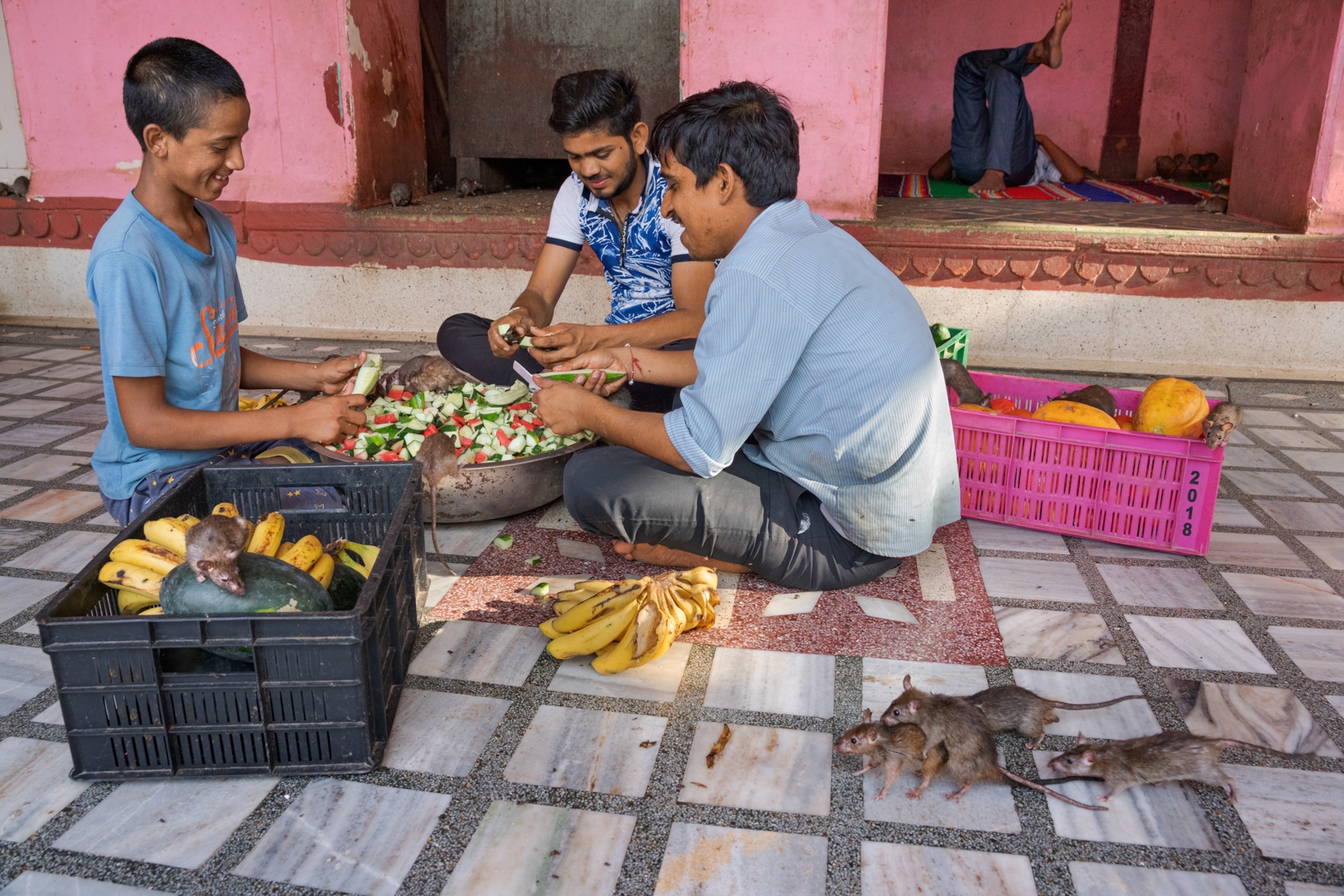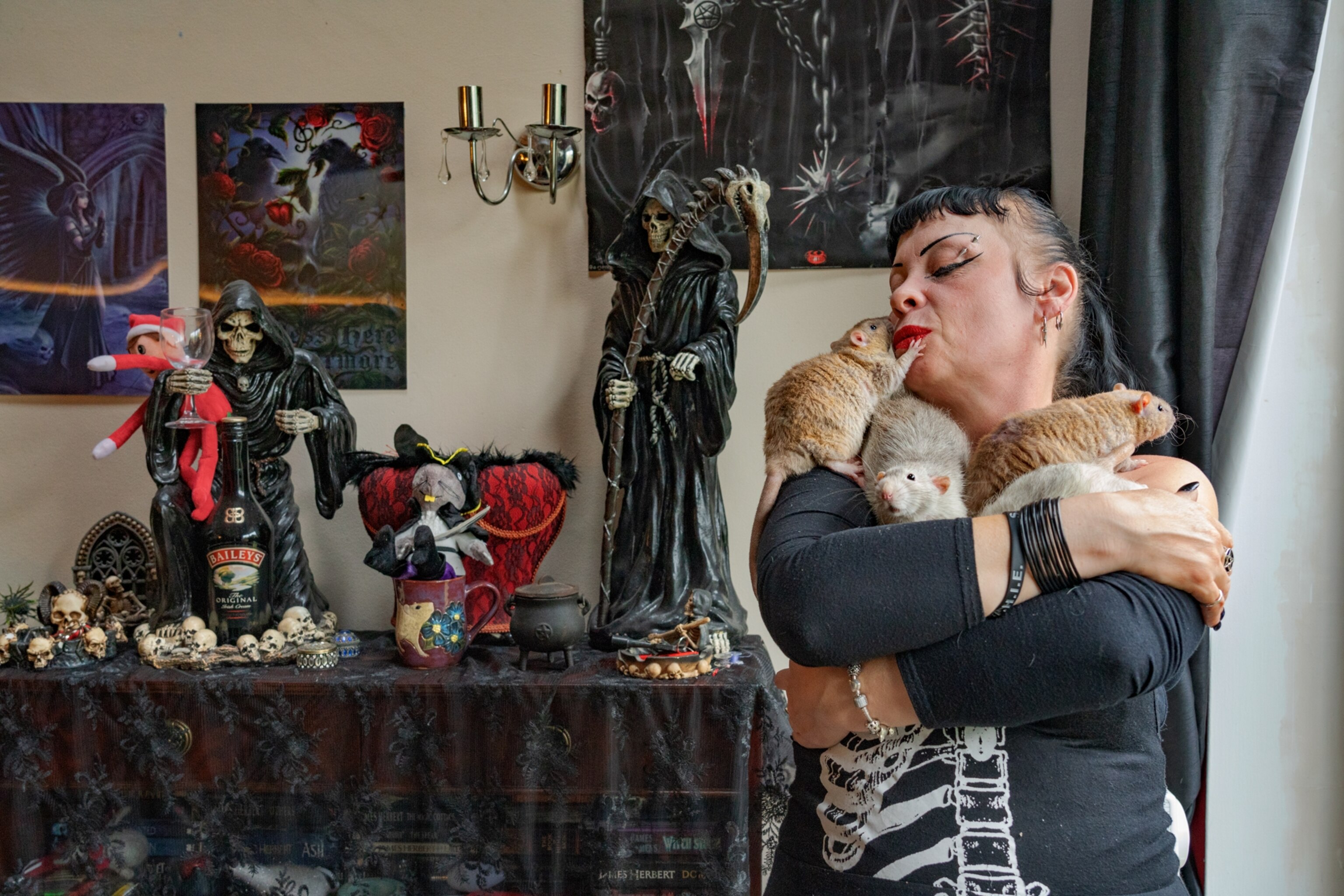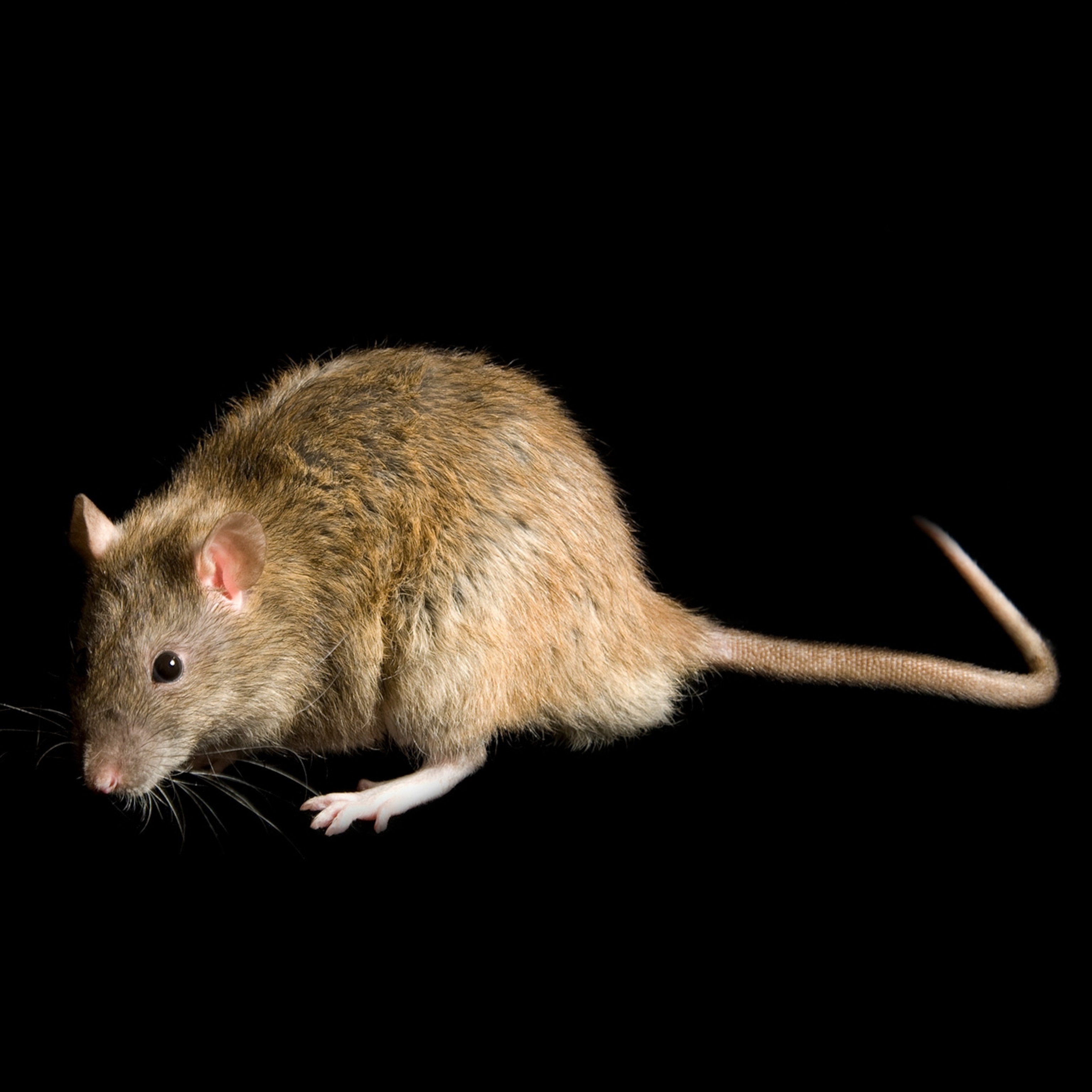
How rats became an inescapable part of city living
In some parts of the world they are revered and protected; in other places they are captured and eaten for dinner. One thing is certain: They’re everywhere.
Rats are our shadow selves. We live on the surface of the city; they generally live below. We mostly work by day; they mostly work by night. But nearly everywhere that people live, rats live too.
In Seattle, where I grew up, the rats excel at climbing sewer pipes—from the inside. Somewhere in my hometown right now, a long, wet Norway rat is poking its twitchy pink nose above the water surface in a toilet bowl. Seattle also has another species, roof rats, which nest in trees and skitter along telephone lines. In the Middle Ages, they may have transmitted plague.
From Seattle to Buenos Aires, urban rat populations are rising—as much as 15 to 20 percent in the past decade, according to one expert. Charismatic animals like elephants, polar bears, and lions are all in decline, yet inside our cities, we find it hard even with extraordinary efforts to keep rat populations in check.

Of all the animals that thrive in our world—pigeons, mice, sparrows, spiders—we feel strongest about rats. Rats have a reputation for being filthy and sneaky. They’re seen as signs of urban decay and carriers of pestilence.
More than any other city creature, they inspire fear and disgust. People hate rats.
Do the little beasts really deserve it? Some of the things we hate most about rats—their dirtiness, their fecundity, their undeniable grit and knack for survival—are qualities that could describe us as well. Their filth is really our own: In most places rats are thriving on our trash and our carelessly tossed leftovers.
“It is us, the humans,” New York rodentologist Bobby Corrigan says. “We don’t keep our nest clean.”
Corrigan is a leading expert on urban rats. He has studied the animals since 1981 and works as a consultant for cities and companies around the world with rat problems. He’s the one who told me about the alarmingly high rate of rat “toilet emergence” in Seattle.
I meet him on his turf on a warm April day at a park in lower Manhattan, one of the rat capitals of the world. Corrigan appears in a hard hat and neon orange vest, holding a clipboard. These accoutrements of authority will allow us to tromp through flower beds and subway tunnels without being challenged. Small statured and intent, Corrigan was raised in a big Irish Catholic family on Long Island. He talks like New Yorkers in the movies.

New Yorkers like to titillate one another with stories about sightings of rats as big as dogs. But the biggest rat Corrigan has ever heard of was a one-pound, 13-ounce creature that hailed from Iraq. He has a standing offer: $500 for anyone who can produce a two-pound rat. He doubts that he will ever have to pay up.
The dominant rat in New York City is the Norway rat, Rattus norvegicus, also known as the brown rat. Brown rats are burrowing animals that are widest at the skull, so they can slip into any space wider than that (including the pipe leading to a toilet bowl). Corrigan points out a small hole directly behind the bench I am sitting on—it’s the main entrance to a rat burrow. He explains that most rat burrows have three entrances, a main entrance and two bolt-holes for quick escapes.
Brown rats live in families. They have two to 14 pups at a time, keep their nests (which they often build in the garden beds of public parks) relatively clean, and patrol small territories. When the pups reach puberty, as early as 10 weeks of age, they move out and look for mates.
Corrigan and I head out on our rat safari. In a flower bed beside a courthouse he paces carefully, feeling the soil beneath his boots. Sensing a hollow space, he jumps up and down heavily a few times. Moments later a rat pops out of a nearby hole and makes a run for it—a dusty brown streak of small-mammal panic. I feel a little bad. Most New Yorkers, however, want all the rats in their city dead.
Just a week before I hunted rats with Corrigan, Mayor Bill de Blasio had announced “an aggressive new extermination plan” against rats in the city’s public housing, part of a $32 million effort to reduce rats by up to 70 percent in the most infested neighborhoods.
Many cities try to control rats with poison. But unfortunately for the rats and for Corrigan’s surprisingly tender heart, fast-acting poisons don’t work well; rats that feel ill after a bite or two stop eating the bait. So the extermination industry uses anticoagulants, or blood thinners, which don’t affect rats for hours and don’t kill them for several days. The rats die slowly from internal bleeding. Corrigan hates to inflict such a death, but he fears outbreaks of disease. So he continues to lend his expertise to clients.
We proceed to Tribeca Park, where according to Corrigan the rats have learned to hunt and kill pigeons. “They leap on their backs like a leopard in the Serengeti,” he says. But tonight the park is quiet. City workers might have recently injected burrows with dry ice, or frozen carbon dioxide, Corrigan says—a more humane approach to killing rats. As carbon dioxide gas wafts off the ice and seeps through the burrows, rats fall asleep, then never wake up.
Few who kill rats for a living hope for more than local or temporary success. After rats are poisoned in an area, Corrigan says, the survivors simply breed until the burrows are full again, and the new generations still find huge mounds of trash bags set out on the sidewalks of New York every night. Until cities radically change how they deal with their trash, Corrigan says, “the rats are winning this war.”
In New York, when you see smoke-colored streaks on the sidewalk, chances are you’re crossing a rat thoroughfare. The oil in their belly fur stains the concrete.
A Night Hunting Rats in the Nation’s Capital



Brown rats likely originated on the Asian steppes, where they first learned they could eat well by hanging out with humans. They spread with trade along the Silk Road, and were established in parts of Europe by about 1500. (The misnomer “Norway rat” may have arisen when an infested ship that happened to be Norwegian docked in an English port.) They colonized today’s United States before it had that name, by the 1750s, and apparently from both the east and the west. Brown rats along the East Coast are descended mostly from European ancestors, but West Coast rats are a mix of European and Asian genetics.
Roof rats—Rattus rattus, also known as black rats—are a global species as well. They may have originated on the Indian subcontinent and adapted to human settlements millennia ago, when humans invented agriculture. They reached Europe by A.D. 300, in time for the decline of the Roman Empire.
Black and brown rats alike traveled with explorers and traders, then settled down to eat our trash and steal our food. Today in Africa the median farm still loses 15 percent of its yield to rats. In Asia rats and other rodents eat enough rice each year to feed 200 million people.
Pacific rats, a third species of Rattus, are a different story: Polynesian explorers sailing from Tahiti and other islands intentionally brought them along in their canoes—as food. They cooked them in their own fat to make rat confit; they made beautiful cloaks of the fur.
As the Polynesians colonized various Pacific islands, tiny rodent explorers settled with them. In fact the rats’ genetic family tree has been used to shed light on when and in what order various islands were discovered. Between 1200 and 1300, Polynesians and their companions reached New Zealand—which until then had no mammals at all other than bats.
Rat Haven





On some small, remote islands, rats have done as much damage as human invaders. On Easter Island they’re suspected of having wiped out palm trees by eating all the nuts. On other islands they threaten seabirds by eating eggs and chicks.
The ecological consequences can be far-reaching and surprising. One study found that by massively reducing bird numbers on some islands in the Indian Ocean’s Chagos Archipelago, rats also interrupted the flow of bird poop into the ocean, where it fertilizes ocean plants. As a result, plant-eating damselfish were smaller and grew more slowly around the islands with rats than the islands without.
Fighting back, conservationists have been trying to eradicate rats with ambitious poisoning campaigns, targeting larger and larger islands. At 1,500 square miles, South Georgia, near Antarctica, is the current record holder: In May 2018 it was declared rat free after helicopters dumped 330 tons of poison in five years on its stark landscape, at a cost of $13 million. With the rats gone, conservationists expect to see an explosion in the number of albatrosses, skuas, terns, petrels, and South Georgia pipits and pintail ducks.

The island nation of New Zealand is thinking even bigger. It plans to kill all the rats in the country—with traps and poison baits spread over some 100,000 square miles—to try to save its rare native birds, including the iconic flightless kiwi.
In Wellington, the capital city, I visit one of the first rat-free oases, a 556-acre sanctuary called Zealandia. Surrounded by a seven-foot metal fence with a mesh too tight even for a rat to wriggle through, the sanctuary is home to such odd birds as the hefty, flightless takahe and the manic hihi. In the global urban landscape, Zealandia is a triumphant anomaly—“a reversal of the idea of the city as a biodiversity wasteland,” says Danielle Shanahan, the sanctuary’s conservation manager.
As the populations of native birds have increased inside the sanctuary, they have spilled over the fence. In response, bird-loving New Zealanders have formed citizens’ groups to trap rats and other predators in parks around Zealandia. The aim is to create a “halo” of habitat that the birds can expand into. Wellington families now spend weekend afternoons acting as rodent death squads, setting and clearing rat traps. For the first time in generations, birds such as the North Island saddleback, or tīeke, can be heard singing their sweet songs in the city center.
Some New Zealanders, however, have doubts about the Predator Free 2050 campaign, which also plans to eradicate stoats and Australian possums. Biologist Wayne Linklater of Victoria University of Wellington calls the plan “unachievable” and says the poisons being used are too cruel. The whole thing is a distraction, he says: Many native species are more threatened by overgrazing and habitat loss than by predation.
Criticism comes also from members of the Ngātiwai, a tribe of Maori on the North Island. Their Polynesian ancestors brought the kiore, as they call the Pacific rat, to New Zealand, and they consider themselves guardians of the rats—which they still eat occasionally. Ngātiwai Trust Board CEO Kris MacDonald describes the kiore as “half the size of a New York sewer rat, all nice and fluffy and tasty looking.”

Off the northeast coast of the North Island, the tribe manages Zealandia’s mirror image: a steep but beautiful rocky islet called Mauitaha, which may be the world’s only rat sanctuary. It’s not exactly teeming—on an overnight visit there, hoping to eat a rat, I failed even to spot one—but someday it may be the only place in the country where kiores persist at all.
Hori Parata, a Ngātiwai environmental resource manager and my guide on Mauitaha, tells me a story about bringing a kiore in a cage to a social gathering. An old man approached and started talking to the rat, tears wetting his face. He had thought they were all gone.
One summer night in Washington, D.C., photographer Charlie Hamilton James and I go rat hunting with a company called Unique Pest Management, which uses trained Patterdale terriers to dispatch rats that are bothering people.
In the Adams Morgan neighborhood, rich in restaurants, we watch the dogs work as a team to kill 31 rats in a single alley—a small fraction of the population, no doubt, but the company claims that with a few visits it can scare survivors into moving away. As the terriers go about their business, the human employees use hockey sticks to stop rats from fleeing the killing zone. Neighbors cheer from their windows.
Despite their bad rap, rats have redeeming qualities. They’re smart—and maybe empathic too. In one study, rats freed other rats from cages, even though it gained them nothing and even when they could have gorged on chocolate instead. The researcher behind the study, neurobiologist Peggy Mason of the University of Chicago, says that typically, once the helper rat frees his companion, “he follows the liberated rat. He jumps on him and he licks him”—apparently to console the distressed animal.
Still, most of us really hate rats. Is it the nocturnal furtiveness, the way rats act like they have something to hide—unlike squirrels, say, which look you in the eye as they raid your bird feeder?
Rats: Farm to Table





“It is the tail,” says Laurinda Williams, who breeds rats on Long Island and sells them as pets. “If it weren’t for the tail, everyone would have rats.”
Val Curtis, a behavioral scientist at the London School of Hygiene & Tropical Medicine and an authority on disgust, says rats are considered disgusting in nearly every human culture—and it’s probably not just the tail. “We are preprogrammed to learn to avoid things that make us sick,” she says. As humans evolved, the ones who didn’t mind sharing space with rats were more likely to die of rat-borne illnesses—and less likely to have descendants—than the ones who were revolted. Thus most of us today have inherited an innate revulsion, Curtis says, “in the same way we are programmed to find saber-tooth tigers scary.”
In the Long Island rattery, which is a room in her parents’ house, Williams shows me animals with fancy coat colors and patterns. She talks about the complexities of keeping the rats healthy and selecting for easy, calm temperaments. It’s a lot of work. The rat room has a strong, musky smell, both sweet and foul. Her scented candle doesn’t quite overpower it.
Williams walks over to a large cage and picks out a fat gray rat with an ivory belly and a split ear from a youthful brawl. His name is Dexter. “This is my heart rat,” she says. “Your favorite rat is your heart rat. You get very bonded.”
I hold Dexter briefly, and he wanders around on my hands. I’m surprised to feel how much he’s trembling.

Corrigan, the rat expert, doesn’t have a heart rat now, but he has owned pet rats in the past. Decades of trying to outsmart them has made him not only respect but really like them.
“I admire this animal. I love this animal. That’s my life’s paradox,” he says.
He welcomes New York’s use of dry ice instead of blood thinners—though the city isn’t doing it just to reduce rat suffering. Hawks, owls, and other raptors are increasingly living in the city, and New Yorkers don’t want to see them dying from eating poisoned rats. The rats are considered vermin; the raptors are welcomed as heartening signs of nature returning to the city.
Scientists these days are working on what might be the ultimate in rat control: a genetic engineering technique that would spread infertility genes through a wild rat population. If fears of unintended consequences can be overcome, this method might one day enable us to wipe out rats on an unheard-of scale, without poison.
Might we miss them? Without rats, New York and other cities would have fewer hawks and owls. Tons of carelessly discarded food would simply putrefy in place, rather than be carried off by a rodent cleanup crew. On YouTube there’s a wildly popular video that shows a New York rat dragging an entire slice of pizza down the stairs of a subway station. A comment praises the animal as “a true New Yorker.”
Rats help keep us from wallowing in our own filth: If we can’t love them for it, respect and a little acceptance would be a healthy step. Outside a soup kitchen near Chinatown, after sunset, I meet a maintenance worker named Jonathan Hincapie who is having a smoke as he watches rats frolic on a heap of trash bags.
I ask if the rats bother him. “I don’t mind rats,” he says. “This is New York City.”
Related Topics
You May Also Like
Go Further
Animals
- Octopuses have a lot of secrets. Can you guess 8 of them?
- Animals
- Feature
Octopuses have a lot of secrets. Can you guess 8 of them? - This biologist and her rescue dog help protect bears in the AndesThis biologist and her rescue dog help protect bears in the Andes
- An octopus invited this writer into her tank—and her secret worldAn octopus invited this writer into her tank—and her secret world
- Peace-loving bonobos are more aggressive than we thoughtPeace-loving bonobos are more aggressive than we thought
Environment
- This ancient society tried to stop El Niño—with child sacrificeThis ancient society tried to stop El Niño—with child sacrifice
- U.S. plans to clean its drinking water. What does that mean?U.S. plans to clean its drinking water. What does that mean?
- Food systems: supporting the triangle of food security, Video Story
- Paid Content
Food systems: supporting the triangle of food security - Will we ever solve the mystery of the Mima mounds?Will we ever solve the mystery of the Mima mounds?
- Are synthetic diamonds really better for the planet?Are synthetic diamonds really better for the planet?
- This year's cherry blossom peak bloom was a warning signThis year's cherry blossom peak bloom was a warning sign
History & Culture
- Strange clues in a Maya temple reveal a fiery political dramaStrange clues in a Maya temple reveal a fiery political drama
- How technology is revealing secrets in these ancient scrollsHow technology is revealing secrets in these ancient scrolls
- Pilgrimages aren’t just spiritual anymore. They’re a workout.Pilgrimages aren’t just spiritual anymore. They’re a workout.
- This ancient society tried to stop El Niño—with child sacrificeThis ancient society tried to stop El Niño—with child sacrifice
- This ancient cure was just revived in a lab. Does it work?This ancient cure was just revived in a lab. Does it work?
- See how ancient Indigenous artists left their markSee how ancient Indigenous artists left their mark
Science
- Jupiter’s volcanic moon Io has been erupting for billions of yearsJupiter’s volcanic moon Io has been erupting for billions of years
- This 80-foot-long sea monster was the killer whale of its timeThis 80-foot-long sea monster was the killer whale of its time
- Every 80 years, this star appears in the sky—and it’s almost timeEvery 80 years, this star appears in the sky—and it’s almost time
- How do you create your own ‘Blue Zone’? Here are 6 tipsHow do you create your own ‘Blue Zone’? Here are 6 tips
- Why outdoor adventure is important for women as they ageWhy outdoor adventure is important for women as they age
Travel
- This royal city lies in the shadow of Kuala LumpurThis royal city lies in the shadow of Kuala Lumpur
- This author tells the story of crypto-trading Mongolian nomadsThis author tells the story of crypto-trading Mongolian nomads
- Slow-roasted meats and fluffy dumplings in the Czech capitalSlow-roasted meats and fluffy dumplings in the Czech capital







